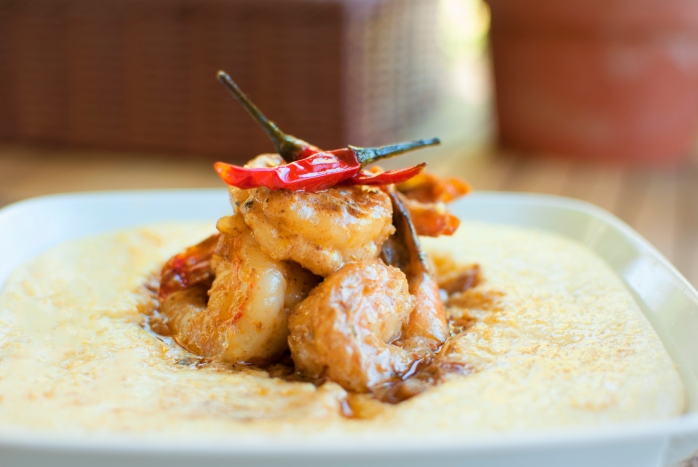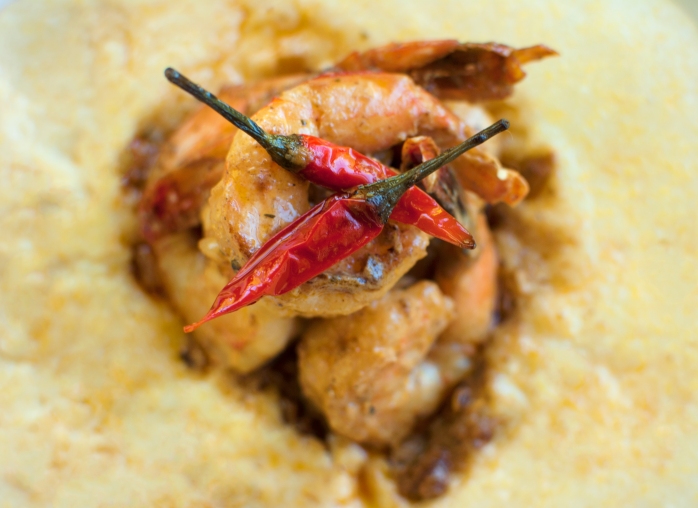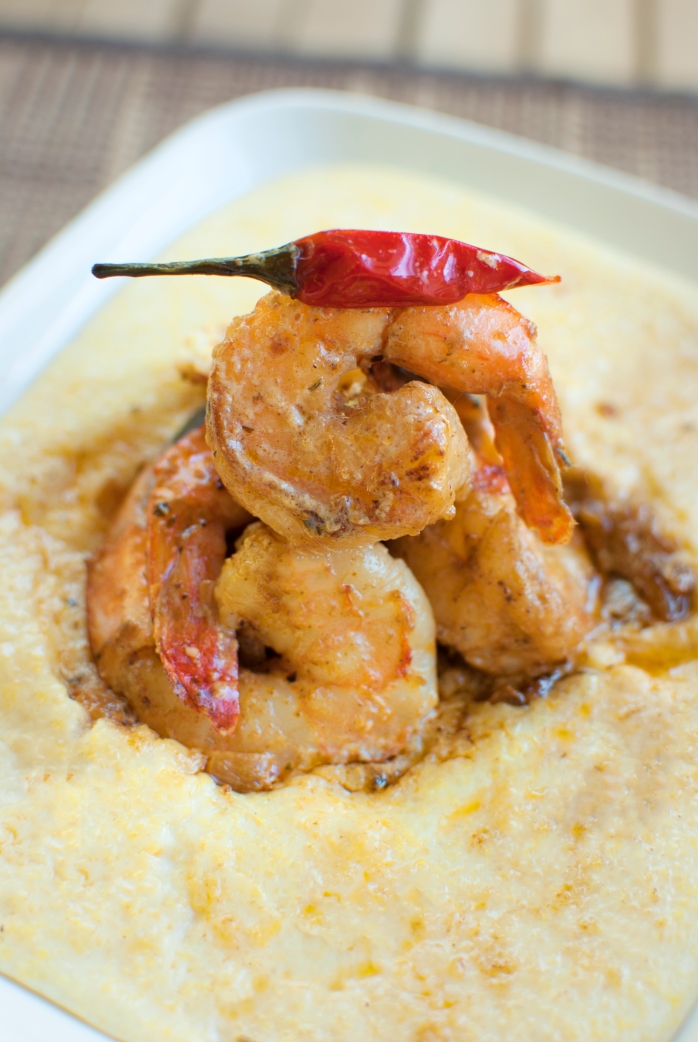Ahoy there mateys!
Alright here we go! I knew this had to be one of the dishes I would submit to Food Network. For one thing we have a dish on our brunch menu at work called Adam’s Shrimp N’ Grits, and it has a lot of fans. I’ve had many people tell me its the best around; actually I got just got a comment card about it on Sunday morning, which I really appreciate! However, you haven’t really had Adam’s Shrimp N’ Grits unless you’ve had this version.

I love infusing exotic flavors into classic American cuisine and I’m a huge fan of Southern American, Creole, or Cajun style food. This dish has grown from humble roots as a simple southern fishermen’s breakfast to gracing many different menus at restaurants all across America. Many chefs have their own take on it. For my version, I’m remixing this classic with the spicy flavors of Thailand.
So what are grits, exactly?
They are definitely one of the more confusing ingredients out there, and the answer to that can get a little complicated. I’ll try to give the Cliff’s Notes. Corn grits are a Southern comfort staple, with Native American roots. Grits are made by cooking ground, dried corn. You can find different varieties, which depend upon the fineness of the grind, and how it’s processed. I usually get mine in the bulk section at Whole Foods where they’re labeled as cornmeal grits. I would avoid anything overly processed such as the ones sold as instant grits. Though slightly different in texture, stone-ground grits, cornmeal grits, hominy grits and polenta are all pretty much interchangeable.
(side note: WordPress wants to correct “polenta” to read “tadpole” instead. )
(side-side note: “polenta” and “tadpole” are however, not interchangeable.)
Grits can be cooked so many different ways that there are actually entire books dedicated to them.(*ahem* gift idea) Grits can be savory or sweet; they can be silky smooth or toothsome; they can be cooled, sliced and then fried; they can even be healthy or indulgent. More often than not, they go the indulgent route — they are considered a comfort food after all. This usually includes milk, cream, butter, and/or cheese. I always prefer to lighten up a dish and try to make it more healthful while still making it delicious. The good news with grits is that you can have your polenta cake and eat it too!

What makes these grits uniquely healthy while simultaneously rich and creamy is that they are made with stock and coconut milk. I added additional flavor to the chicken stock by throwing in some lemongrass I had lying around. (no, not uncommon in my kitchen).
It’s amazing how creamy they are without any cream, butter, or cheese! They are also gluten-free and vegan assuming you use vegetable stock… but then you know, don’t add the shrimp, or whatever. Grits are so versatile, you can eat just about anything with them. I also love poached eggs with mine.
Since there are only 2 major components to this dish, they have to both be perfect. This means no skimpy shrimpies! You have to get the best shrimp available to you. Go for the largest, freshest ones you can find. You really don’t want the pre-cooked variety either. You will infuse more flavor into them if they go in the pan raw.
Time to turn up the heat a little bit.

With the shrimp, you can really afford to kick things into high gear on the Scoville scale. Somewhere between hot and nuclear should be just right. What I absolutely love about shrimp and grits together is that you can make the shrimp devilishly spicy, but the creamy grits will save your face! (but you know…don’t go eating any whole Thai chili peppers) If you don’t like spicy, I would at least go heavy on the garlic.
For this version, I made my own curry paste. By all means, go buy a curry paste at your Asian market or an overpriced one from the international aisle of your mainstream grocer. I prefer to make mine though because some of the ingredients in the store-bought variety are suspect to me. I mean have you ever actually SEEN shrimp paste, for example? Well I have, and uh… Maki Zavelli, over and out. Bai.
Generally for curry pastes, I process garlic, ginger, chili peppers, herbs and spices, and sometimes throw in random Asian sauces and pastes I have in the fridge. Korean Gochuchang and Japanese Miso are some of my favorites to go to.
Sorry I don’t have process photos. They look terrible in my kitchen with my current equipment and I didn’t have a helper available. I’ll outline my suggested process below, but keep in mind that there is a lot of room for personal interpretation. You can use different types of stocks, aromatics, fats, and spices. I always encourage people to learn cooking techniques, but to be adaptive to their tastes in regards to ingredients and flavors.
Ingredients:
1 cup cornmeal grits
4 cups stock (chicken, fish, or vegetable)
1 can coconut milk
6-8 pieces of shrimp per serving, deveined
2 Tbsp (eyeball it) garlic, minced
1 Tbsp (eyeball it) ginger, minced
1 small onion, diced
1 red bell pepper, diced
3 Thai chili peppers (omit if they scare you)
1 Tbsp curry paste, red, panang or home-made
lime
Grits:
Bring 4 cups of stock to a boil. Add additional aromatics if using.
(conveniently they typically come in 4 cup size)
Add 1 cup of grits. Gradually add them to the stock while whisking.
Reduce heat to LOW. Let them cook low and slow for about 15 minutes, whisking occasionally. If they seize up a bit or look a little tight, that’s ok because we are adding coconut milk as well.
Add about 1/2 to 3/4 a can of coconut milk to your preference. Some people like really creamy grits, and some like them with a little more texture. As long as they aren’t too runny or totally seized up, there really isn’t a right or wrong consistency — it’s preference. Reserve the rest of the coconut milk for later.
Shrimp:
Heat your skillet. Once hot, turn your heat down to medium. Butter is the classic fat to use here and is admittedly the best partner to shrimp, but you can also use olive, coconut, or some other good oil. You can also use a blend; I used a mix of coconut oil and butter. Add your freshly minced garlic, ginger, onion, peppers, and curry paste. Don’t forget to add some salt and any other seasonings you might like. It’s pretty easy to make your own curry paste, but you can buy pre-made ones at the Asian market. I would suggest the Thai red or panang style curry pastes. The amount is up to preference.
Add your shrimp. Let everything brown in the pan a bit before adding the reserved coconut milk. Allow the shrimp to finish cooking in this broth and take off the heat as soon as they’re done or right before they’re done. Hit the shrimp with a little fresh lime juice. Shrimp are easy to over cook, but the big, fresh ones are more forgiving than the small or pre-cooked shrimp that turn to tiny bits of rubber if you overcook them.
1 cup of uncooked grits yields about 4-5 cups cooked. I’d figure about 1 cup per serving, but could be more or less based on preference. They are surprisingly filling though!

Next time you make grits, you should really try using stock instead of water and coconut milk instead of cream and butter. I promise you they are absolutely de-lish! So creamy you would think they were made with cream. If you’ve never tried shrimp and grits, go find a local restaurant that is known for them, and see what you’re missing!
I attempted to work on a post for 4th of July, but it didn’t really come together. Trying to make any food naturally blue usually doesn’t… but Happy Independence Day anyway! I’m gonna go back to enjoying my day off, and I hope you have a great holiday filled with great food, friends and weather!
Until next time,
May the fish be with you!
~Maki Zavelli




